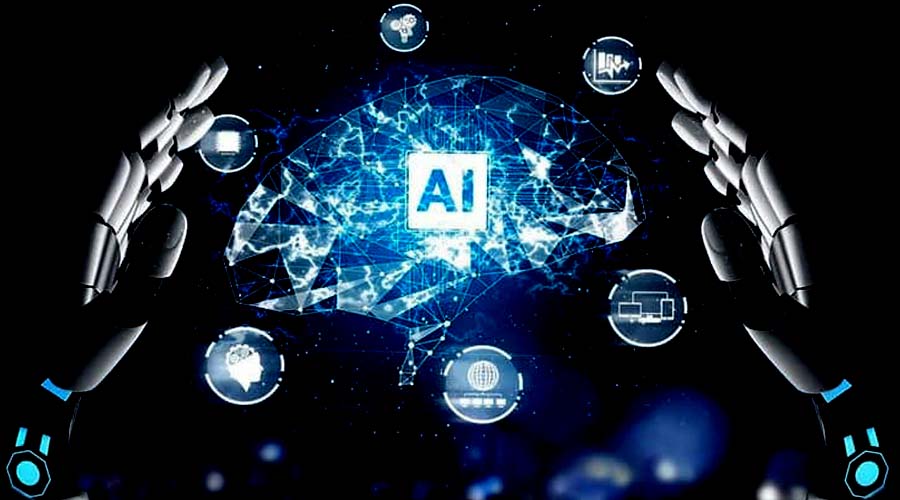Harnessing The Power Of Artificial Intelligence: A Journey Into Innovation

Harnessing the Power of Artificial Intelligence: A Journey into Innovation
Introduction
Artificial Intelligence (AI) has emerged as a transformative technology, revolutionizing various industries and unlocking unprecedented possibilities. This article delves into the immense power of AI and its potential to drive innovation across diverse domains. By exploring the transformative applications of AI in fields such as healthcare, finance, manufacturing, and beyond, we embark on a groundbreaking journey into the future of innovation.
Healthcare Revolutionized by AI
In the healthcare sector, AI is proving to be a game-changer. AI-powered algorithms can analyze vast amounts of patient data to identify patterns and predict diseases with remarkable accuracy. This enables early diagnosis, personalized treatments, and tailored drug discovery. Surgery is also becoming more precise and efficient with AI-assisted robotic systems that enhance surgeons’ capabilities. Moreover, AI chatbots and virtual assistants are providing round-the-clock medical assistance and support, improving patient care and reducing strain on healthcare providers.
AI Transforming Finance
The financial industry is experiencing a significant transformation driven by AI. AI algorithms can analyze market data, identify trends, and make predictions with unprecedented speed and accuracy. This empowers financial institutions to optimize investment strategies, manage risk more effectively, and provide tailored financial advice to clients. AI is also revolutionizing fraud detection, automating tasks, and enhancing customer service, leading to improved efficiency and customer satisfaction.
Manufacturing Redefined by AI
AI’s transformative impact extends to the manufacturing sector. AI-powered systems can optimize production processes, predict maintenance needs, and identify potential defects. This results in increased productivity, reduced downtime, and improved quality control. Additionally, AI-enabled robots are revolutionizing assembly lines, automating repetitive tasks, and working alongside human workers to improve efficiency and safety.
Beyond Specific Industries: AI’s Broader Implications
The impact of AI extends far beyond individual industries. AI is empowering researchers to tackle complex scientific challenges, such as drug discovery, climate modeling, and materials science. It is also enhancing the capabilities of self-driving cars, making transportation safer and more efficient. Moreover, AI is revolutionizing communication through natural language processing, enabling machines to understand and respond to human language, bridging the gap between humans and computers.
Drivers of AI Innovation
The rapid advancements in AI are driven by several key factors. The availability of vast amounts of data, coupled with increased computational power, enables AI algorithms to learn from and adapt to complex patterns. Additionally, the development of new AI techniques, such as deep learning and machine learning, is unlocking new possibilities for AI applications.
Conclusion
The journey into AI innovation is an ongoing adventure, with the potential to transform every aspect of our lives. By harnessing the power of AI, we can address complex challenges, improve efficiency, and unlock new possibilities across industries. As we continue to explore the frontiers of AI, we embark on a path toward a future where innovation and human ingenuity converge, leading us to a more prosperous and technologically advanced society.## Harnessing The Power Of Artificial Intelligence: A Journey Into Innovation
Executive Summary
Artificial Intelligence (AI) is revolutionizing the world as we know it, offering businesses and individuals a wealth of opportunities to innovate and improve efficiency. This article delves into the transformative power of AI, exploring its key applications, benefits, and challenges. By harnessing the capabilities of AI, we can unlock unprecedented potential and shape the future of our industries and society as a whole.
Introduction
In the ever-evolving landscape of technology, artificial intelligence stands as a beacon of innovation, promising to reshape industries and empower us in ways we never imagined. AI encompasses a vast array of techniques and algorithms that enable machines to learn, analyze data, and make decisions with remarkable accuracy and speed. By leveraging the power of AI, we can automate tasks, optimize processes, and gain valuable insights, driving growth and progress across all sectors.
FAQs
-
What is AI?
AI refers to computer systems that are designed to perform tasks that typically require human intelligence, such as learning, problem-solving, and decision-making. -
What are the benefits of AI?
AI offers numerous benefits, including increased efficiency, enhanced decision-making, improved customer service, and the ability to automate complex tasks. -
What are the challenges of AI?
The implementation of AI also presents certain challenges, including data privacy concerns, the need for skilled professionals, and the potential for job displacement.
Top 5 Subtopics
Machine Learning
Machine learning is a subset of AI that allows computers to learn from data without explicit programming. It involves algorithms that can identify patterns, make predictions, and adapt to changing conditions.
- Supervised learning: The model learns from labeled data, where the input and output are known.
- Unsupervised learning: The model learns from unlabeled data, identifying patterns and structures without prior knowledge.
- Reinforcement learning: The model learns through trial and error, receiving rewards or penalties for its actions.
- Deep learning: A type of machine learning that uses artificial neural networks to process large amounts of data.
- Natural language processing (NLP): Enables computers to understand and generate human language.
Computer Vision
Computer vision empowers computers to “see” and interpret images and videos. It involves techniques for object recognition, image classification, and facial recognition.
- Image recognition: Identifying objects and their attributes within images.
- Object detection: Locating and identifying objects in images or videos, often with bounding boxes.
- Facial recognition: Identifying individuals based on their facial features.
- Medical imaging: Analyzing medical images for diagnostic purposes, such as detecting tumors or abnormalities.
- Autonomous vehicles: Enabling self-driving cars to navigate and identify obstacles.
Natural Language Processing (NLP)
NLP allows computers to understand and generate human language. It involves techniques for text analysis, language translation, and speech recognition.
- Text analysis: Extracting meaning and insights from written text, such as sentiment analysis or topic modeling.
- Language translation: Translating text from one language to another, preserving the meaning and context.
- Speech recognition: Converting spoken words into text, enabling voice assistants and other applications.
- Chatbots: Automated conversational agents that can interact with users in natural language.
- Text summarization: Condensing large text into concise summaries, highlighting key points.
Robotics
Robotics combines AI, computer vision, and other technologies to create intelligent machines that can perform physical tasks.
- Industrial robots: Automating tasks in manufacturing, logistics, and other industries.
- Service robots: Assisting humans in various tasks, such as cleaning, delivering, or providing customer service.
- Medical robots: Performing surgeries, delivering medication, or providing rehabilitation therapy.
- Autonomous drones: Flying robots that can be used for surveillance, delivery, or exploration.
- Exoskeletons: Wearable devices that enhance human mobility and strength.
AI Ethics
As AI becomes more pervasive, ethical considerations become paramount. AI ethics addresses the responsible development and use of AI, ensuring it aligns with human values and societal norms.
- Data privacy: Protecting user data and ensuring its responsible use.
- Bias and fairness: Mitigating biases in AI systems to ensure equitable outcomes.
- Transparency and accountability: Making AI systems understandable and accountable.
- Human oversight: Maintaining human control over AI systems and preventing unintended consequences.
- Job displacement: Addressing the potential impact of AI on employment and developing strategies for reskilling and upskilling.
Conclusion
Artificial intelligence is a transformative force that holds immense potential for innovation, efficiency, and societal progress. By embracing the power of AI, we can unlock new possibilities, automate tasks, enhance decision-making, and create a better future. However, it is crucial to approach AI development and deployment with ethical considerations at the forefront, ensuring its responsible and beneficial use. Together, let us harness the power of AI to shape a world that is both innovative and equitable.




